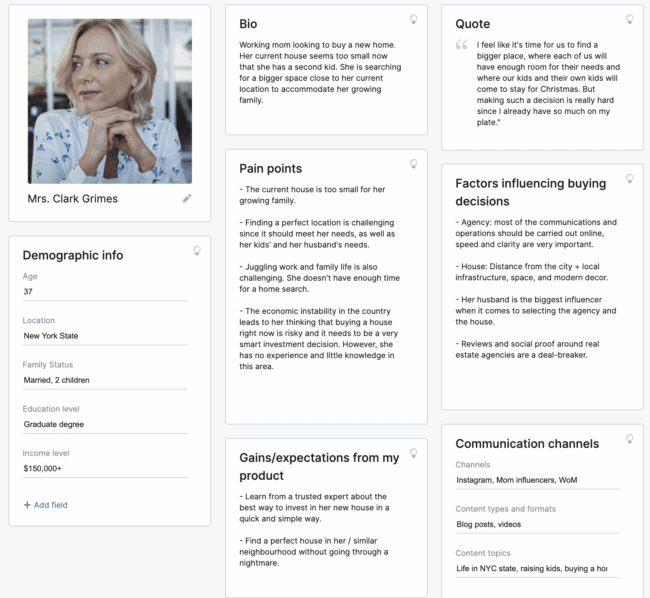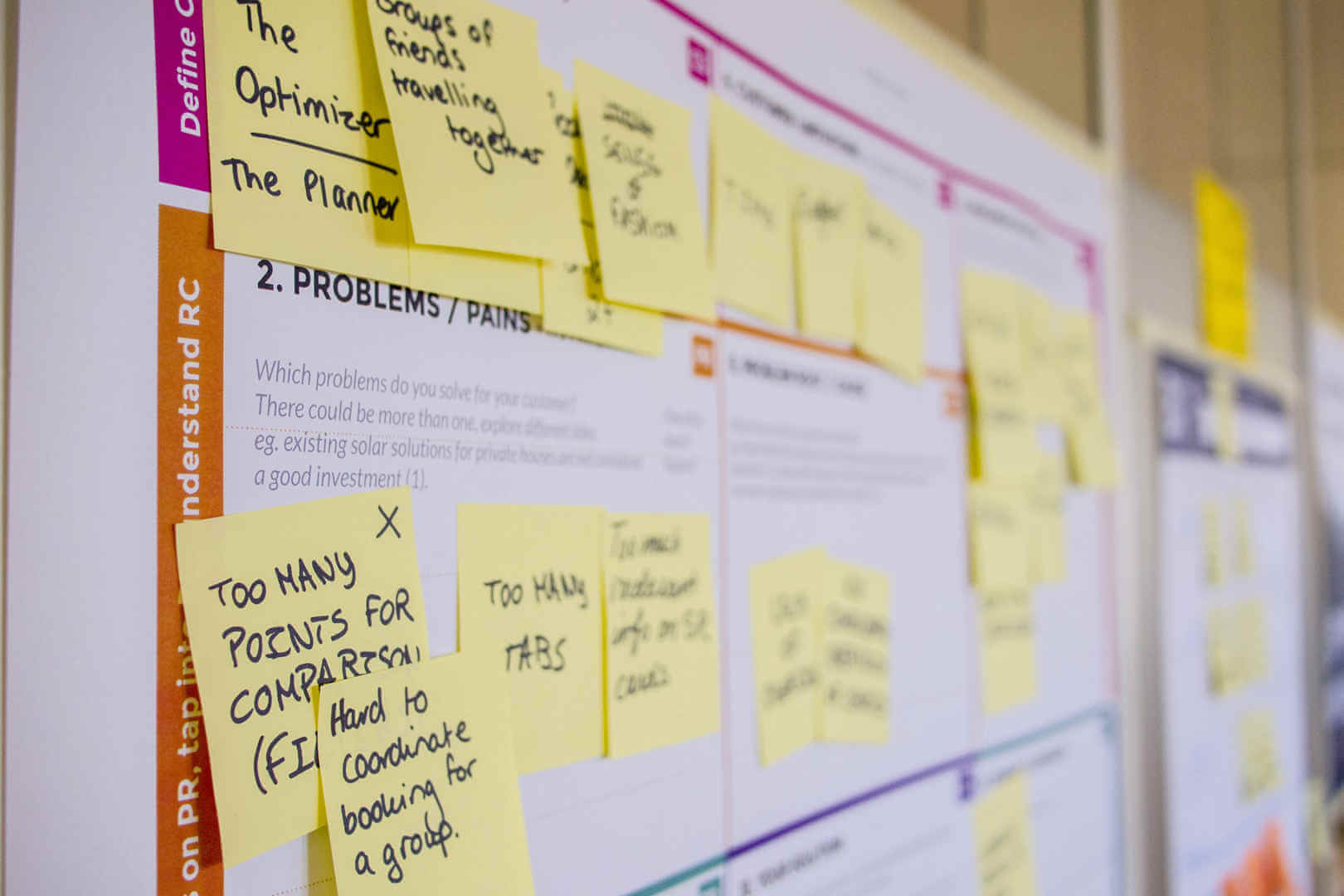Looking for a digital agency with a proven track record of improving customer personas? Credo has digital agencies ready to deliver personas tailored to your brand. Schedule a free call with our team to get started.

In the digitally-dominated landscape of today, your customer persona is the holy grail of your marketing strategy.But are you doing everything you can to get as granular and specific as possible with yours?
If not, you should, because people not only expect engaging content nowadays. That goes without saying. What they also expect is hyper-personalized messaging that speaks to their personal beliefs, demographics, biggest challenges, favorite pastimes, and more. A customer persona is how you make sure you’re doing that.
Table of Contents
What is a customer persona?
A customer persona is a semi-fictional profile of your ideal customer. Also called buyer personas, most brands have at least a couple of these that cover their entire customer base in as much detail as possible. You create your personas based on data and research on the customers you already have—and on your competitor’s customers.
To help visualize what a customer persona should look like, here is one example:

Customer personas like this not only help you identify your customers but also why they will use your products or services. After you know these variables, you can cater new product development to the customer persona, and make sure you stay hyper-focused on the most qualified prospects possible.
Your brand’s customer persona
You probably have a good handle on who your brand’s customers are and how to create content and ads that attract them. Hopefully, your entire business—from marketing to sales—is aligning goals toward your personas.
After all, it’s what defines important parts of your marketing strategy, including:
- Which channels you should use to reach prospects;
- How you should reach out to potential customers;
- The frequency with which you engage them;
- Why they decide to convert;
- Why they did not convert (because there’s value in that, too).
As a modern brand, you know how important customer personas are. But many companies simply don’t have these answers nailed down. Ideally, you should have a fictionalized customer persona that explains everything about the person you are speaking to in any piece of content and all of your ads.
Now, knowing something’s important is one thing. Acting on that is an entirely different animal. Because—believe me when I say this—I absolutely get it: most marketers have a lot of things going on. Every day brings urgent fires that need to be put out right away, making it easier to put something like a customer persona on the back burner.
But if it’s created and adjusted properly, a customer persona can have a huge impact on the rest of your marketing tasks and campaigns. It’s a point of leverage that can help you turn around poor-performing campaigns and make successful ones even better.
If you can’t remember the last time you updated your customer persona – or you don’t have one ironed out just yet – this article will be especially valuable for your brand. The framework below is a starting point. From here, iterate on this framework for the best results with your own content marketing customer personas.
Evaluate where you are
Before you spend a lot of time planning an update to your buyer persona, the first step is knowing what you have so far. Obviously, if you don’t have a buyer persona, you can skip this step.
But thanks to the prevalence of content marketing, even the newest start-ups are creating and maintaining buyer personas. Compared to more traditional methods, a customer persona is one of the most cost-effective ways to invest in your digital marketing strategy. Indeed, a customer persona improves your overall ROAS (return on ad spend) by delivering content to people who actually want your product or services.
If you do have a previous buyer persona, there are probably elements of it that you can use going forward – even if only as a template for what kind of things to avoid in the new version.
It’s likely that the core characteristics of your target audience haven’t changed. For example, if you’re working on a buyer persona for a B2B SaaS-services brand that targets IT managers, you may not need to change their attributes as much as the ways you reach them. And equally important, the channel you use to reach them.
Take some time to look at previous customer persona documents, research reports, Google Analytics, surveys, and any other form of feedback you may have on hand that influences the way you craft your brand’s persona.
Even if the material is outdated, it will still provide a starting point from which you can work on new additions to your buyer persona.

Dive into your research
Once you know what you have already, you’re ready to start building on it to update your customer persona. Start with the lowest-hanging fruit – has there been a significant event or news story in your industry that has significantly changed the way your customers and prospects would consider your purchase?
Maybe there’s a new communication channel or platform that many of your customers are using. For example, despite its association with younger users, TikTok is increasingly being used by older generations.
According to recent data published by the network, the hashtag “#momsoftiktok” has 44 billion views. Sure, many of these views and videos are for entertainment reasons, but those users are also potential customers. If you know how to target them.
The key to this part of the process is being objective. Go into your buyer persona research with a clear mind – don’t let your expectations or the things that have worked previously influence your decisions.
Where should you go to perform research for an updated buyer persona? You can certainly use the same sources you used originally, but in case you need some ideas, try these:
- Previous sales data, ideally from after the last time you made or refreshed your persona. Think about the problem that drove them to your company, the things they said when you engaged with them, and the things they liked most about your offerings.
- Groups on social networks including Facebook and LinkedIn. These platforms are excellent for staying up to date on the newest trends involving your industry and/or customers. Look for the posts or contributions that receive the most engagement in the form of likes and responses. They could be issues you need to address in your persona.
- Check industry publications including blogs, magazines, and columns within larger publications. See if you can identify a particular theme or challenge that your customers and prospects are dealing with more often than usual.
[Related reading: How To Build A Marketing Plan]
Get input from customers
It’s always best to get buyer persona information from a primary source: your actual customers. Depending on the type of product or service you sell, you probably create anywhere from a handful to dozens of persona profiles.
Focus on your ideal customer when getting feedback from current customers. This will help you adjust your buyer persona so that you attract the people who are a great fit for your business.
When you solicit feedback from customers, make sure to keep it brief. Ask them a few questions about their biggest challenges at work and the ways in which your offering helps the most. Whichever way you choose to gather feedback, make sure it doesn’t take your customers more than 5 or 10 minutes.
Ideally, you can offer some kind of incentive to encourage customers to give you information about your buyer persona. Even something small like a gift card to a local coffee shop can help. A better option is something tied directly to your brand. Smart brands offer a one-time discount on their product or services to customers who help improve their marketing strategy.
This is especially true if you feel like you need to ask for in-depth information that takes more than a handful of minutes. Don’t expect people to devote significant amounts of their time just to help your marketing team. Your customer’s attention is your most valuable asset so treat it accordingly.
Repeat your customer persona refresh
After doing research to build on your existing customer persona and gathering feedback from your top customers, you should now have enough data to update the persona.
Also, remember not to make changes just for the sake of changing things. If you’ve found that not much has changed since the last time you worked on your buyer persona, that’s okay. Stick with what works and make slight adjustments as needed. Remember, this should be an iterative process that is never truly complete.
Why? Because the key to maximizing the success of your buyer persona is to make it a living document. You can’t create a buyer persona and then let it sit idle in a folder somewhere for years and years. It’s important to revisit the persona to ensure that it stays relevant to the largest possible portion of your current customer base.
The more comprehensive and detailed you can get on your buyer persona, the better. It can take a good bit of time and effort to develop a fleshed-out persona profile. This is especially valid if you have a complicated offering or you serve several different industries.
In these cases, it may be best to let third-party marketing professionals work on your buyer persona.
Credo can connect you with our network of vetted digital marketing agencies. They have deep experience across the most common marketing disciplines including buyer personas, content marketing, and more.
Whether you’re looking to generate a brand new buyer persona or you just need to tweak your old one with some new updates, we can match you with the right marketing providers for your needs.
If you’re ready to shorten the amount of time it takes you to bring on the marketing partner you need for consistent growth, schedule a free consultation with us today to learn how to get started.

